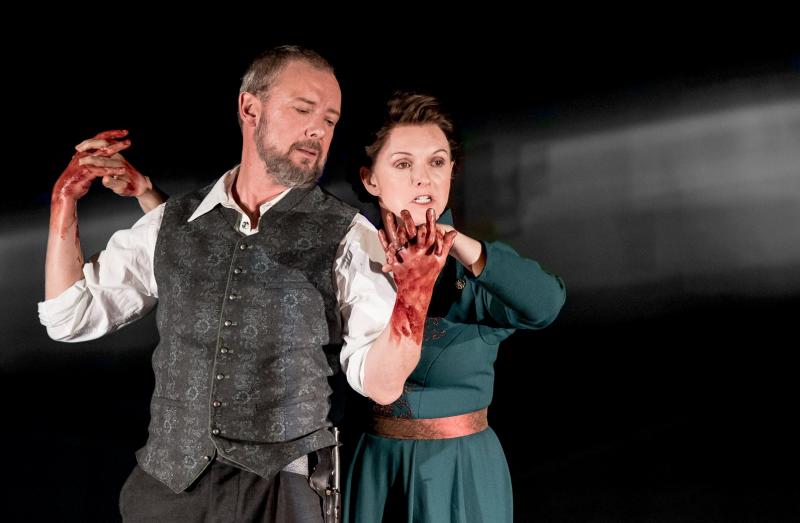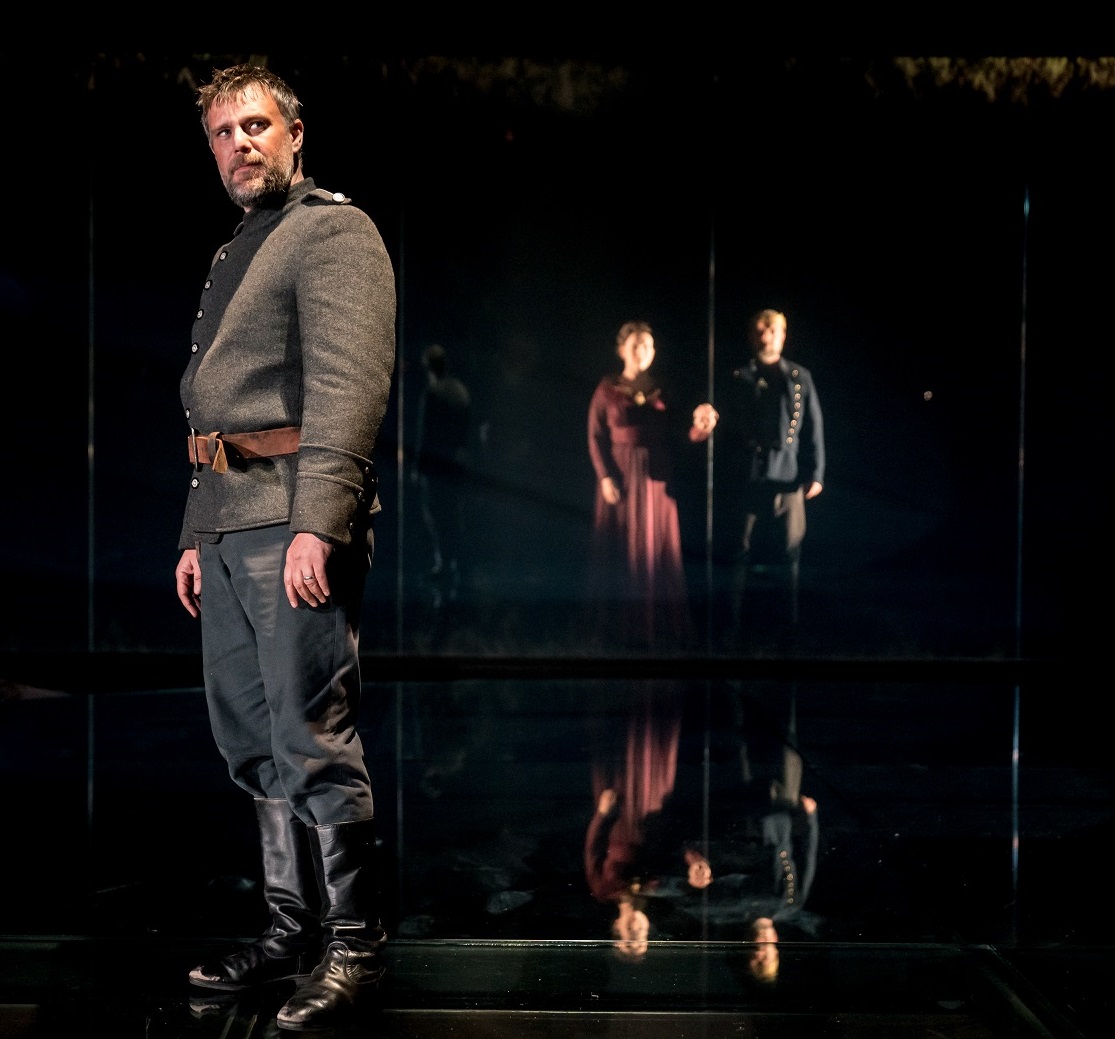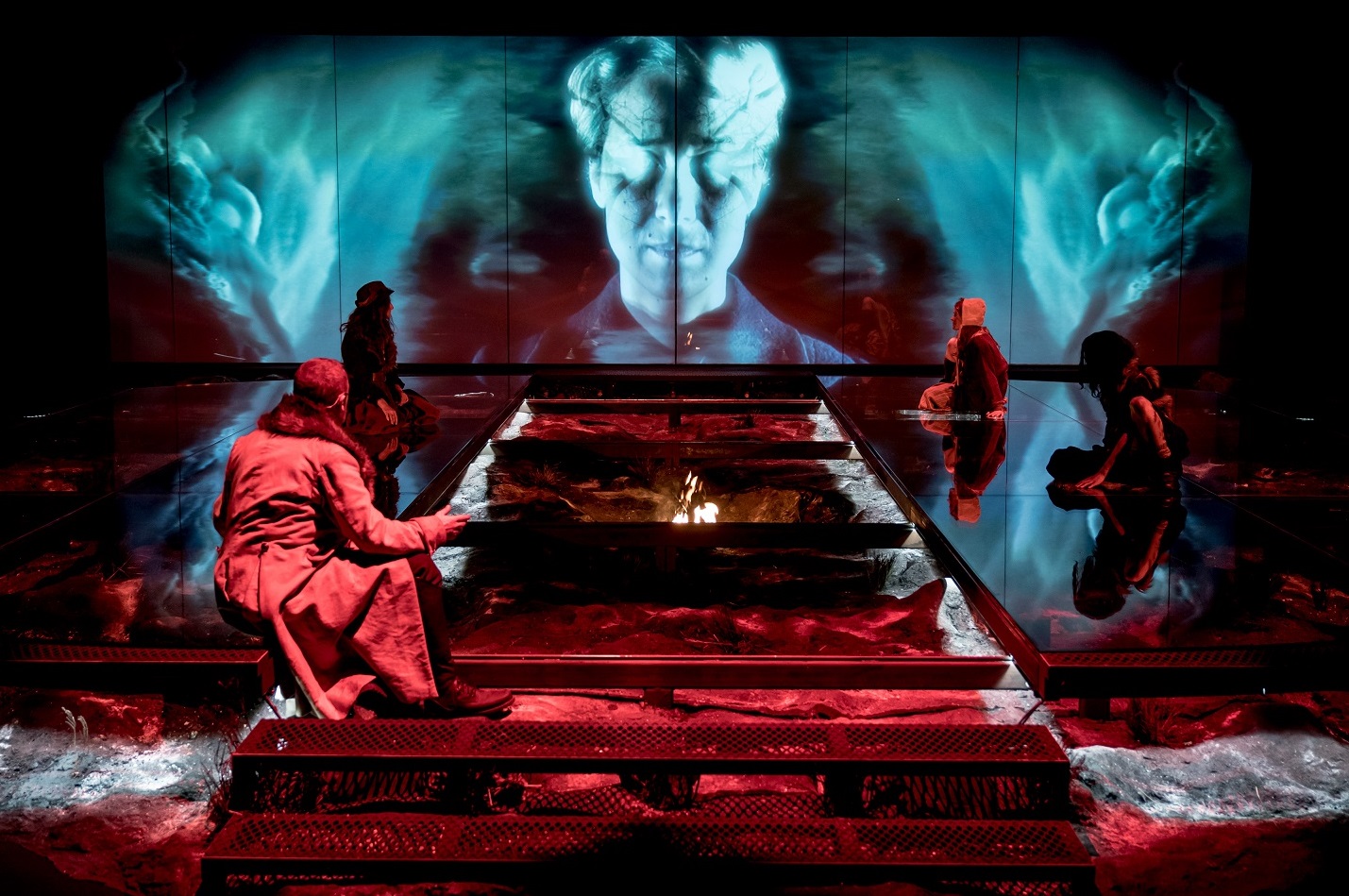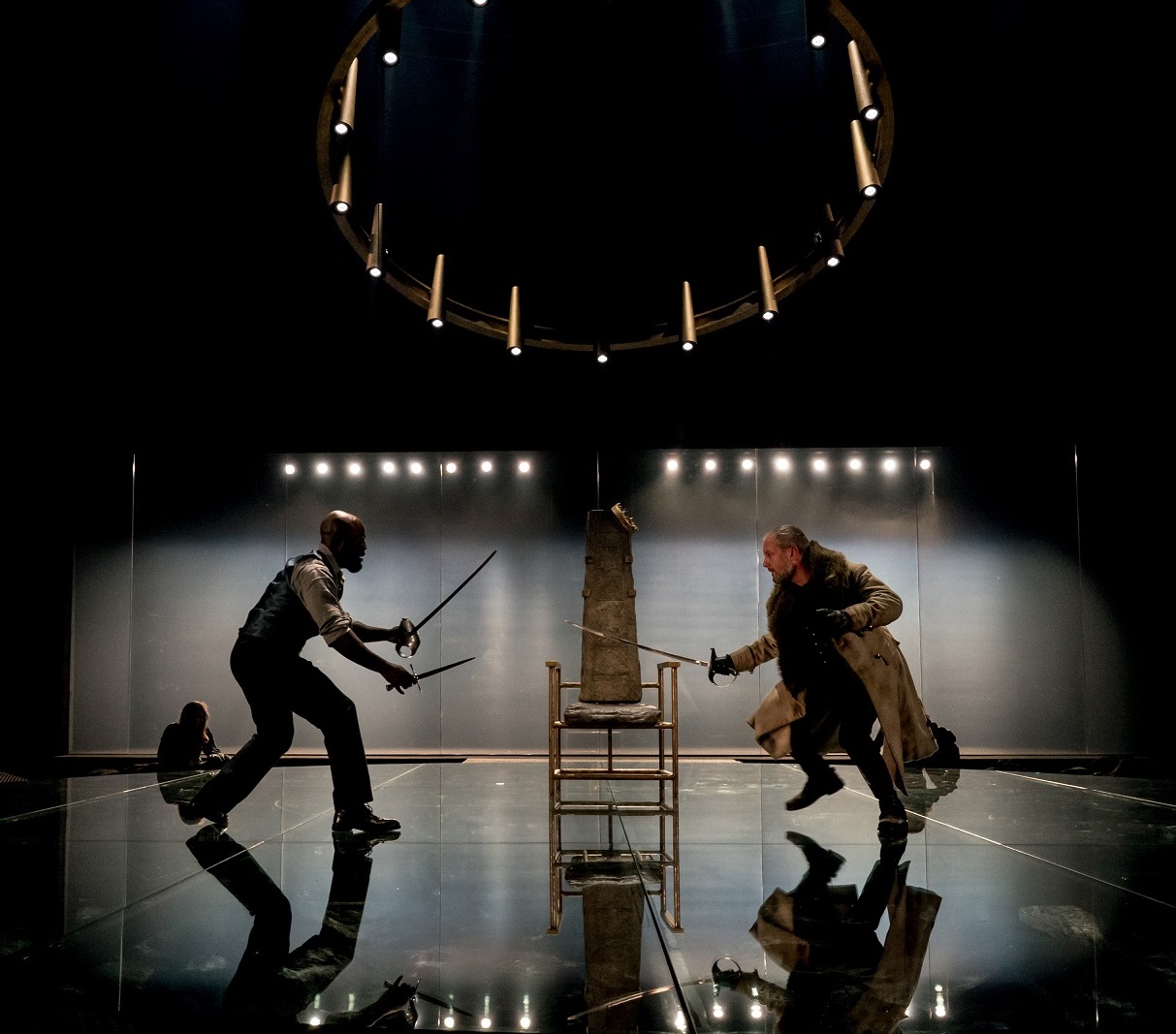Macbeth, Chichester Festival Theatre review - cosmic yet closely crafted | reviews, news & interviews
Macbeth, Chichester Festival Theatre review - cosmic yet closely crafted
Macbeth, Chichester Festival Theatre review - cosmic yet closely crafted
John Simm is a strikingly intelligent Thane in an expansively designed production

There’s a fine balance between the cosmic and the closely crafted in director Paul Miller’s Macbeth, his first production in the expansive space that is Chichester’s main stage.
There’s restraint in the pairing with Dervla Kirwan as Lady Macbeth, too, no overstressing of passion between these two. Bloodying her own hands in his, Kirwan is certainly his partner in crime, though at other times they could be a troubled couple out of Bergman as much as the impulsive wreckers of the nation’s peace; her key moments, “Unsex me here” among them, are also accomplished with a degree of holding back. Macbeth’s “O, full of scorpions is my mind” catches his sharp, occasionally sarcastic power, the sense of poise remaining even as his world careens later towards chaos. There's a striking last-act stage picture created by designer Simon Daw, Simm solitary on his throne, a tilted crown of lights framing him from above, the festering inexorability of the moment palpable.
 Daw relishes the possibilities of his circular glass stage from the start, with the witches gyring crazily around it in expanding spirals (they later linger around the edge of the action, too). The decisive moment when Macbeth has them conjure the future is especially effective, when the surface divides to accommodate the flames of their cauldron (pictured below). That’s a high point for Tim Reid’s video projections, which revel in the images of mania and destiny that prove so mortifying to Macbeth; his lack of legacy seems especially to trouble him, brought home by the line of Banquo’s descendants stretching out into the future that the visual effect crystallises so memorably. When such visual effects align with the action, the result is spectacular, though occasionally they feel overused (as when Lady Macbeth’s words accompany her in script form). With its looming brass and distressed percussion, there are virtually Wagnerian touches to Max Pappenheim’s score, the production edifice completed by a busy sound design that rumbles away beneath everything. (Pictured above, Stuart Laing as Banquo)
Daw relishes the possibilities of his circular glass stage from the start, with the witches gyring crazily around it in expanding spirals (they later linger around the edge of the action, too). The decisive moment when Macbeth has them conjure the future is especially effective, when the surface divides to accommodate the flames of their cauldron (pictured below). That’s a high point for Tim Reid’s video projections, which revel in the images of mania and destiny that prove so mortifying to Macbeth; his lack of legacy seems especially to trouble him, brought home by the line of Banquo’s descendants stretching out into the future that the visual effect crystallises so memorably. When such visual effects align with the action, the result is spectacular, though occasionally they feel overused (as when Lady Macbeth’s words accompany her in script form). With its looming brass and distressed percussion, there are virtually Wagnerian touches to Max Pappenheim’s score, the production edifice completed by a busy sound design that rumbles away beneath everything. (Pictured above, Stuart Laing as Banquo)
There are satisfying visual moments with banqueting tables laid out, the tableau that welcomes Duncan seen behind the screen while the Macbeths plot in front of it; the interplay of space and projection works beautifully for the uneasy follow-up dinner scene, as Macbeth’s mania sets in (“Then comes my fit again”) and he is haunted by Banquo’s ghost and other images (a huge empty eye is especially strong). In a general, out-of-time military style of costuming – with some subtly beautiful greens and dark reds for Kirwan as Lady Macbeth – only Daw’s choice of homburg headwear for assorted courtiers doesn’t convince, giving them the look of seedy 20th century detectives, particularly bizarre when preparations for the final battle are underway. Does such weighty technical accompaniment risk dominating the text and performances themselves? That may be a matter of taste, but for me the varying visual interplay between isolated figures and back projections gave a distinct insight, while verse speaking is excellent. Stuart Laing’s Banquo has a martial directness that contrasts with Simm’s calculation, while the deep graciousness of Christopher Ravenscroft’s Duncan is nicely accentuated by the naivety of Beatriz Romilly’s notably youthful (cross-cast) Malcolm, who in turn plays well with Michael Balogun’s Macduff in their scene in English exile, the sky blues of its projections counterpointing the troubled darkness of Scotland (the allusions to “swift blessing/May soon return to this our suffering country” and “milk of concord” surely ring with particular resonance today). On the bathetic side, the humour of Harry’s Peacock’s Porter is refreshing, while Macbeth’s sardonic acknowledgement of the two murderers, “Aye, in the catalogue ye go for men”, raises a welcome laugh. (Pictured below, Michael Balogun as Macduff, John Simm as Macbeth)
Does such weighty technical accompaniment risk dominating the text and performances themselves? That may be a matter of taste, but for me the varying visual interplay between isolated figures and back projections gave a distinct insight, while verse speaking is excellent. Stuart Laing’s Banquo has a martial directness that contrasts with Simm’s calculation, while the deep graciousness of Christopher Ravenscroft’s Duncan is nicely accentuated by the naivety of Beatriz Romilly’s notably youthful (cross-cast) Malcolm, who in turn plays well with Michael Balogun’s Macduff in their scene in English exile, the sky blues of its projections counterpointing the troubled darkness of Scotland (the allusions to “swift blessing/May soon return to this our suffering country” and “milk of concord” surely ring with particular resonance today). On the bathetic side, the humour of Harry’s Peacock’s Porter is refreshing, while Macbeth’s sardonic acknowledgement of the two murderers, “Aye, in the catalogue ye go for men”, raises a welcome laugh. (Pictured below, Michael Balogun as Macduff, John Simm as Macbeth)
 But it’s the moments of sheer silence that follow some of Simm’s soliloquies, resounding as they do over and above any supporting effects, which stay in the mind. Simm certainly gives us a sense of his character developing as the action proceeds, even if the antecedent forces that follow the witches’ predictions and impel him towards murder seem less clear. Simm and Miller are following the course of Shakespeare’s tragic heroes, their Hamlet already in the bag from the director’s time at Sheffield. We’ll have to wait a decade or so before Lear beckons, but the spare visual style and wide perspectives that Miller has crafted here should work a treat for that one, too.
But it’s the moments of sheer silence that follow some of Simm’s soliloquies, resounding as they do over and above any supporting effects, which stay in the mind. Simm certainly gives us a sense of his character developing as the action proceeds, even if the antecedent forces that follow the witches’ predictions and impel him towards murder seem less clear. Simm and Miller are following the course of Shakespeare’s tragic heroes, their Hamlet already in the bag from the director’s time at Sheffield. We’ll have to wait a decade or so before Lear beckons, but the spare visual style and wide perspectives that Miller has crafted here should work a treat for that one, too.
rating
Explore topics
Share this article
The future of Arts Journalism
You can stop theartsdesk.com closing!
We urgently need financing to survive. Our fundraising drive has thus far raised £49,000 but we need to reach £100,000 or we will be forced to close. Please contribute here: https://gofund.me/c3f6033d
And if you can forward this information to anyone who might assist, we’d be grateful.

Subscribe to theartsdesk.com
Thank you for continuing to read our work on theartsdesk.com. For unlimited access to every article in its entirety, including our archive of more than 15,000 pieces, we're asking for £5 per month or £40 per year. We feel it's a very good deal, and hope you do too.
To take a subscription now simply click here.
And if you're looking for that extra gift for a friend or family member, why not treat them to a theartsdesk.com gift subscription?
more Theatre
 Othello, Theatre Royal, Haymarket review - a surprising mix of stateliness and ironic humour
David Harewood and Toby Jones at odds
Othello, Theatre Royal, Haymarket review - a surprising mix of stateliness and ironic humour
David Harewood and Toby Jones at odds
 Macbeth, RSC, Stratford review - Glaswegian gangs and ghoulies prove gripping
Sam Heughan's Macbeth cannot quite find a home in a mobster pub
Macbeth, RSC, Stratford review - Glaswegian gangs and ghoulies prove gripping
Sam Heughan's Macbeth cannot quite find a home in a mobster pub
 The Line of Beauty, Almeida Theatre review - the 80s revisited in theatrically ravishing form
Alan Hollinghurst novel is cunningly filleted, very finely acted
The Line of Beauty, Almeida Theatre review - the 80s revisited in theatrically ravishing form
Alan Hollinghurst novel is cunningly filleted, very finely acted
 Wendy & Peter Pan, Barbican Theatre review - mixed bag of panto and comic play, turned up to 11
The RSC adaptation is aimed at children, though all will thrill to its spectacle
Wendy & Peter Pan, Barbican Theatre review - mixed bag of panto and comic play, turned up to 11
The RSC adaptation is aimed at children, though all will thrill to its spectacle
 Hedda, Orange Tree Theatre review - a monument reimagined, perhaps even improved
Scandinavian masterpiece transplanted into a London reeling from the ravages of war
Hedda, Orange Tree Theatre review - a monument reimagined, perhaps even improved
Scandinavian masterpiece transplanted into a London reeling from the ravages of war
 The Assembled Parties, Hampstead review - a rarity, a well-made play delivered straight
Witty but poignant tribute to the strength of family ties as all around disintegrates
The Assembled Parties, Hampstead review - a rarity, a well-made play delivered straight
Witty but poignant tribute to the strength of family ties as all around disintegrates
 Mary Page Marlowe, Old Vic review - a starry portrait of a splintered life
Tracy Letts's Off Broadway play makes a shimmeringly powerful London debut
Mary Page Marlowe, Old Vic review - a starry portrait of a splintered life
Tracy Letts's Off Broadway play makes a shimmeringly powerful London debut
 Little Brother, Soho Theatre review - light, bright but emotionally true
This Verity Bargate Award-winning dramedy is entertaining as well as thought provoking
Little Brother, Soho Theatre review - light, bright but emotionally true
This Verity Bargate Award-winning dramedy is entertaining as well as thought provoking
 The Unbelievers, Royal Court Theatre - grimly compelling, powerfully performed
Nick Payne's new play is amongst his best
The Unbelievers, Royal Court Theatre - grimly compelling, powerfully performed
Nick Payne's new play is amongst his best
 The Maids, Donmar Warehouse review - vibrant cast lost in a spectacular-looking fever dream
Kip Williams revises Genet, with little gained in the update except eye-popping visuals
The Maids, Donmar Warehouse review - vibrant cast lost in a spectacular-looking fever dream
Kip Williams revises Genet, with little gained in the update except eye-popping visuals
 Ragdoll, Jermyn Street Theatre review - compelling and emotionally truthful
Katherine Moar returns with a Patty Hearst-inspired follow up to her debut hit 'Farm Hall'
Ragdoll, Jermyn Street Theatre review - compelling and emotionally truthful
Katherine Moar returns with a Patty Hearst-inspired follow up to her debut hit 'Farm Hall'
 Troilus and Cressida, Globe Theatre review - a 'problem play' with added problems
Raucous and carnivalesque, but also ugly and incomprehensible
Troilus and Cressida, Globe Theatre review - a 'problem play' with added problems
Raucous and carnivalesque, but also ugly and incomprehensible

Add comment